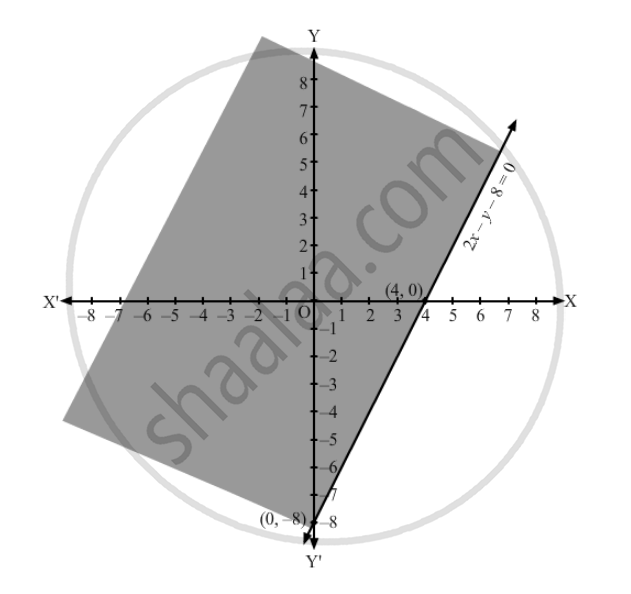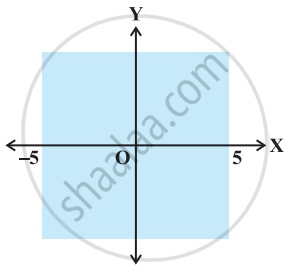Advertisements
Advertisements
Question
Represent to solution set of each of the following inequations graphically in two dimensional plane:
y ≥ 2x − 8
Solution
Converting the inequation to equation, we obtain 2x \[-\] y\[-\]8 =0
Putting y = 0 and x = 0 in this equation, we obtain x = 4 and y = \[-\]8 respectively.
So, this line meets the x-axis at (4,0) and y-axis at (0,\[-\]8).
We plot these points and join them by a thick line.This divides the xy plane into two parts.
To determine the region represented by the given inequality, consider point O(0,0).
Clearly, (0,0) does satisfy the inequality.
So, the region containing the origin is represented by the given inequality.
Hence, the shaded region is the solution to the inequation.

APPEARS IN
RELATED QUESTIONS
Solve 24x < 100, when x is an integer.
Solve –12x > 30, when x is an integer.
Solve 5x – 3 < 7, when x is an integer.
Solve 3x + 8 > 2, when x is an integer.
Solve 3x + 8 > 2, when x is a real number.
Solve the given inequality for real x: 4x + 3 < 5x + 7.
Solve the given inequality for real x: 3(x – 1) ≤ 2 (x – 3)
Solve the given inequality for real x : `x/3 > x/2 + 1`
Solve the given inequality for real x : `(3(x-2))/5 <= (5(2-x))/3`
Solve the given inequality for real x: 2(2x + 3) – 10 < 6 (x – 2)
Solve the given inequality for real x: `x/4 < (5x - 2)/3 - (7x - 3)/5`
Solve the given inequality for real x: `((2x- 1))/3 >= ((3x - 2))/4 - ((2 - x))/5`
Solve the given inequality and show the graph of the solution on number line:
`x/2 >= ((5x -2))/3 - ((7x - 3))/5`
Find all pairs of consecutive odd positive integers both of which are smaller than 10 such that their sum is more than 11.
Find all pairs of consecutive even positive integers, both of which are larger than 5 such that their sum is less than 23.
Solve the inequality.
2 ≤ 3x – 4 ≤ 5
Solve the inequality.
6 ≤ –3(2x – 4) < 12
Solve the inequality.
`-3 <= 4 - (7x)/2 <= 18`
Solve the inequality.
`7 <= (3x + 11)/2 <= 11`
Represent to solution set of each of the following inequations graphically in two dimensional plane:
x + 2y − y ≤ 0
Represent to solution set of each of the following inequations graphically in two dimensional plane:
x + 2 ≥ 0
Represent to solution set of each of the following inequations graphically in two dimensional plane:
5. −3x + 2y ≤ 6
Represent to solution set of each of the following inequations graphically in two dimensional plane:
3y ≥ 6 − 2x
Solutions of the inequalities comprising a system in variable x are represented on number lines as given below, then ______.![]()
State whether the following statement is True or False.
If x > y and b < 0, then bx < by
State whether the following statement is True or False.
If xy > 0, then x > 0, and y < 0
State whether the following statement is True or False.
If xy < 0, then x > 0, and y > 0
State whether the following statement is True or False.
If x > 5 and x > 2, then x ∈ (5, ∞)
State whether the following statement is True or False.
If |x| < 5, then x ∈ (–5, 5)
The inequality representing the following graph is ______.
Solution of a linear inequality in variable x is represented on number line given below ______.
Solution of a linear inequality in variable x is represented on number line given below ______.

Solution of a linear inequality in variable x is represented on number line given below ______.

If x > –2 and x < 9, then x ∈ (– 2, 9)
